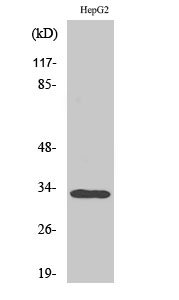DcR3 Polyclonal Antibody
- Catalog No.:YT1303
- Applications:WB;IHC;IF;ELISA
- Reactivity:Human
- Target:
- DcR3
- Fields:
- >>Cytokine-cytokine receptor interaction
- Gene Name:
- TNFRSF6B
- Protein Name:
- Tumor necrosis factor receptor superfamily member 6B
- Human Gene Id:
- 8771
- Human Swiss Prot No:
- O95407
- Immunogen:
- The antiserum was produced against synthesized peptide derived from human TNFRSF6B. AA range:251-300
- Specificity:
- DcR3 Polyclonal Antibody detects endogenous levels of DcR3 protein.
- Formulation:
- Liquid in PBS containing 50% glycerol, 0.5% BSA and 0.02% sodium azide.
- Source:
- Polyclonal, Rabbit,IgG
- Dilution:
- WB 1:500 - 1:2000. IHC 1:100 - 1:300. IF 1:200 - 1:1000. ELISA: 1:5000. Not yet tested in other applications.
- Purification:
- The antibody was affinity-purified from rabbit antiserum by affinity-chromatography using epitope-specific immunogen.
- Concentration:
- 1 mg/ml
- Storage Stability:
- -15°C to -25°C/1 year(Do not lower than -25°C)
- Other Name:
- TNFRSF6B;DCR3;TR6;Tumor necrosis factor receptor superfamily member 6B;Decoy receptor 3;DcR3;Decoy receptor for Fas ligand;M68
- Observed Band(KD):
- 32kD
- Background:
- This gene belongs to the tumor necrosis factor receptor superfamily. The encoded protein is postulated to play a regulatory role in suppressing FasL- and LIGHT-mediated cell death. It acts as a decoy receptor that competes with death receptors for ligand binding. Over-expression of this gene has been noted in gastrointestinal tract tumors. Read-through transcription into this gene from the neighboring upstream gene, which encodes regulator of telomere elongation helicase 1 (RTEL1), generates a non-coding transcript. [provided by RefSeq, Feb 2011],
- Function:
- alternative products:Additional isoforms seem to exist,function:ATP-dependent DNA helicase required to suppress inappropriate homologous recombination, thereby playing a central role DNA repair and in the maintenance of genomic stability. Antagonizes homologous recombination by promoting the disassembly of D loop recombination intermediates. Also required to regulate telomere length; probably due to its anti-recombinase function.,function:Decoy receptor for the cytotoxic ligands TNFS14/LIGHT and TNFSF6/FASL. Protects against apoptosis.,miscellaneous:Amplified in gastric tumors.,similarity:Belongs to the helicase family. RAD3/XPD subfamily.,similarity:Contains 1 helicase ATP-binding domain.,similarity:Contains 4 TNFR-Cys repeats.,tissue specificity:Detected in fetal lung, brain and liver. Detected in adult stomach, spinal cord, lymph node, trachea, spleen, colon and lung. Highly expressed
- Subcellular Location:
- Secreted.
- Expression:
- Detected in fetal lung, brain and liver. Detected in adult stomach, spinal cord, lymph node, trachea, spleen, colon and lung. Highly expressed in several primary tumors from colon, stomach, rectum, esophagus and in SW480 colon carcinoma cells.
- June 19-2018
- WESTERN IMMUNOBLOTTING PROTOCOL
- June 19-2018
- IMMUNOHISTOCHEMISTRY-PARAFFIN PROTOCOL
- June 19-2018
- IMMUNOFLUORESCENCE PROTOCOL
- September 08-2020
- FLOW-CYTOMEYRT-PROTOCOL
- May 20-2022
- Cell-Based ELISA│解您多样本WB检测之困扰
- July 13-2018
- CELL-BASED-ELISA-PROTOCOL-FOR-ACETYL-PROTEIN
- July 13-2018
- CELL-BASED-ELISA-PROTOCOL-FOR-PHOSPHO-PROTEIN
- July 13-2018
- Antibody-FAQs
- Products Images

- Western Blot analysis of various cells using DcR3 Polyclonal Antibody cells nucleus extracted by Minute TM Cytoplasmic and Nuclear Fractionation kit (SC-003,Inventbiotech,MN,USA).

- Western blot analysis of TNFRSF6B Antibody. The lane on the right is blocked with the TNFRSF6B peptide.

- Immunohistochemistryt analysis of paraffin-embedded human colon t carcinoma, using TNFRSF6B Antibody. The lane on the right is blocked with the TNFRSF6B peptide.

- Immunofluorescence analysis of TNFRSF6B Antibody. The lane on the right is blocked with the TNFRSF6B peptide.

- Immunofluorescence analysis of HepG2 cells, using TNFRSF6B Antibody. The picture on the right is blocked with the synthesized peptide.

- Immunohistochemistry analysis of paraffin-embedded human colon carcinoma tissue, using TNFRSF6B Antibody. The picture on the right is blocked with the synthesized peptide.

- Western blot analysis of the lysates from HT-29 cells using TNFRSF6B antibody.



